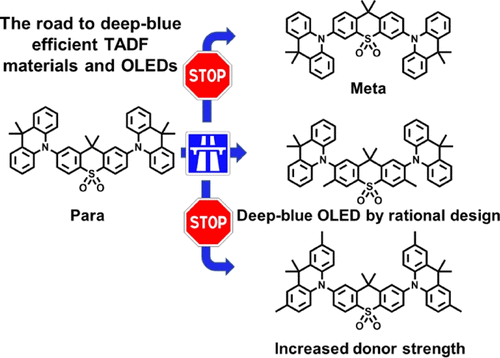当前位置:
X-MOL 学术
›
ACS Appl. Mater. Interfaces
›
论文详情
Our official English website, www.x-mol.net, welcomes your
feedback! (Note: you will need to create a separate account there.)
Molecular Design Strategies for Color Tuning of Blue TADF Emitters.
ACS Applied Materials & Interfaces ( IF 8.3 ) Pub Date : 2019-07-17 , DOI: 10.1021/acsami.9b06364 Patrycja Stachelek , Jonathan S Ward , Paloma L Dos Santos , Andrew Danos , Marco Colella , Nils Haase 1, 2 , Samuel J Raynes , Andrei S Batsanov , Martin R Bryce , Andrew P Monkman
ACS Applied Materials & Interfaces ( IF 8.3 ) Pub Date : 2019-07-17 , DOI: 10.1021/acsami.9b06364 Patrycja Stachelek , Jonathan S Ward , Paloma L Dos Santos , Andrew Danos , Marco Colella , Nils Haase 1, 2 , Samuel J Raynes , Andrei S Batsanov , Martin R Bryce , Andrew P Monkman
Affiliation

|
New thermally activated delayed fluorescence (TADF) blue emitter molecules based on the known donor-acceptor-donor (D-A-D)-type TADF molecule, 2,7-bis(9,9-dimethylacridin-10-yl)-9,9-dimethylthioxanthene-S,S-dioxide (DDMA-TXO2), are reported. The motivation for the present investigation is via the use of rational molecular design, based on DDMA-TXO2, to elevate the organic light emitting diode (OLED) performance and obtain deeper blue color coordinates. To achieve this goal, the strength of the donor (D) unit and acceptor (A) units have been tuned with methyl substituents. The methyl functionality on the acceptor was also expected to modulate the D-A torsion angle in order to obtain a blue shift in the electroluminescence. The effect of regioisomeric structures has also been investigated. Herein, we report the photophysical, electrochemical, and single-crystal X-ray crystallography data to assist with the successful OLED design. The methyl substituents on the DDMA-TXO2 framework have profound effects on the photophysics and color coordinates of the emitters. The weak electron-donating methyl groups alter the redox properties of the D and A units and consequently affect the singlet and triplet levels but not the energy gap (ΔEST). By systematically manipulating all of the aforementioned factors, devices have been obtained with acceptor-substituted III with a maximum external quantum efficiency of 22.6% and Commission Internationale de l'Éclairage coordinates of (0.15, 0.18) at 1000 cd m-2.
中文翻译:

蓝色TADF发射体颜色调整的分子设计策略。
基于已知的供体-受体-供体(DAD)型TADF分子,2,7-双(9,9-二甲基ac啶-10-基)-9,9-二甲基硫杂蒽的新的热活化延迟荧光(TADF)蓝色发射体分子报告了-S,S-二氧化物(DDMA-TXO2)。本研究的动机是通过使用基于DDMA-TXO2的合理分子设计来提高有机发光二极管(OLED)的性能并获得更深的蓝色坐标。为了实现该目标,已经用甲基取代基调节了供体(D)单元和受体(A)单元的强度。还预期受体上的甲基官能度可调节DA扭转角,以便在电致发光中获得蓝移。还研究了区域异构结构的作用。在这里,我们报告了光物理,电化学,和单晶X射线晶体学数据可帮助成功进行OLED设计。DDMA-TXO2骨架上的甲基取代基对发射体的光物理性质和颜色坐标有深远的影响。给电子体弱的甲基会改变D和A单元的氧化还原特性,因此会影响单线态和三线态的能级,但不会影响能隙(ΔEST)。通过系统地操纵所有上述因素,获得了具有受体取代的III的器件,其最大外部量子效率为22.6%,在1000 cd m-2时具有(0.15,0.18)的国际佣金坐标为(0.15,0.18)。DDMA-TXO2骨架上的甲基取代基对发射体的光物理性质和颜色坐标有深远的影响。给电子体弱的甲基会改变D和A单元的氧化还原特性,因此会影响单线态和三线态的能级,但不会影响能隙(ΔEST)。通过系统地操纵所有上述因素,获得了具有受体取代的III的器件,该器件的最大外部量子效率为22.6%,在1000 cd m-2时的国际照明委员会坐标为(0.15,0.18)。DDMA-TXO2骨架上的甲基取代基对发射体的光物理性质和颜色坐标有深远的影响。给电子体弱的甲基会改变D和A单元的氧化还原特性,因此会影响单线态和三线态的能级,但不会影响能隙(ΔEST)。通过系统地操纵所有上述因素,获得了具有受体取代的III的器件,该器件的最大外部量子效率为22.6%,在1000 cd m-2时的国际照明委员会坐标为(0.15,0.18)。
更新日期:2019-07-17
中文翻译:

蓝色TADF发射体颜色调整的分子设计策略。
基于已知的供体-受体-供体(DAD)型TADF分子,2,7-双(9,9-二甲基ac啶-10-基)-9,9-二甲基硫杂蒽的新的热活化延迟荧光(TADF)蓝色发射体分子报告了-S,S-二氧化物(DDMA-TXO2)。本研究的动机是通过使用基于DDMA-TXO2的合理分子设计来提高有机发光二极管(OLED)的性能并获得更深的蓝色坐标。为了实现该目标,已经用甲基取代基调节了供体(D)单元和受体(A)单元的强度。还预期受体上的甲基官能度可调节DA扭转角,以便在电致发光中获得蓝移。还研究了区域异构结构的作用。在这里,我们报告了光物理,电化学,和单晶X射线晶体学数据可帮助成功进行OLED设计。DDMA-TXO2骨架上的甲基取代基对发射体的光物理性质和颜色坐标有深远的影响。给电子体弱的甲基会改变D和A单元的氧化还原特性,因此会影响单线态和三线态的能级,但不会影响能隙(ΔEST)。通过系统地操纵所有上述因素,获得了具有受体取代的III的器件,其最大外部量子效率为22.6%,在1000 cd m-2时具有(0.15,0.18)的国际佣金坐标为(0.15,0.18)。DDMA-TXO2骨架上的甲基取代基对发射体的光物理性质和颜色坐标有深远的影响。给电子体弱的甲基会改变D和A单元的氧化还原特性,因此会影响单线态和三线态的能级,但不会影响能隙(ΔEST)。通过系统地操纵所有上述因素,获得了具有受体取代的III的器件,该器件的最大外部量子效率为22.6%,在1000 cd m-2时的国际照明委员会坐标为(0.15,0.18)。DDMA-TXO2骨架上的甲基取代基对发射体的光物理性质和颜色坐标有深远的影响。给电子体弱的甲基会改变D和A单元的氧化还原特性,因此会影响单线态和三线态的能级,但不会影响能隙(ΔEST)。通过系统地操纵所有上述因素,获得了具有受体取代的III的器件,该器件的最大外部量子效率为22.6%,在1000 cd m-2时的国际照明委员会坐标为(0.15,0.18)。































 京公网安备 11010802027423号
京公网安备 11010802027423号